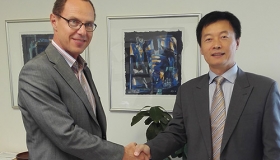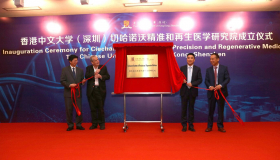CUHK (SZ) Hosts 2016 Sino-foreign Cooperative University
On 15 April, the 2016 Sino-foreign Cooperative University Union Presidents Forum was held at The Chinese University of Hong Kong, Shenzhen (“University”). Aside from the University, attendees also included officials and representatives from union members (The University of Nottingham Ningbo China, Xi’an Jiaotong-Liverpool University, New York University Shanghai, Wenzhou-Kean University, Duke Kunshan University, and Beijing Normal University-Hong Kong Baptist University United International College) as well as two universities which are still in preparatory stage (Guangdong Technion-Israel Institute of Technology and Shenzhen-BIT-Moscow University). The purpose of the meeting was to explore the development trend of these universities and exchange experiences in running such schools.
Government officials invited to the event included HAO Ping, vice minister of Ministry of Education, XU Tao, Head of Department of International Cooperation and Exchanges, LUO Weiqi, Head of Department of Education of Guangdong Province, WU Yihuan , vice mayor of Shenzhen Municipal Government and YANG Li, vice district chief of Longgang District, Shenzhen.
The theme of the conference is to explore faculty development, discuss international education based on Chinese cultural background, identify the roles that Sino-foreign cooperative universities play in boosting the development of high level tertiary institutions, and analyze how running a university contributes to local economy.
Boost China’s Higher Education Reform
HAO Ping, vice minister of Ministry of Education, addressed the achievements made by Sino-foreign cooperative universities. He also mentioned that Shenzhen, the frontrunner in China’s reform and opening up campaign, has once again taken lead in educational reform, particularly in exploring Sino-foreign joint venture universities.
According to Mr. HAO, a third assessment agency was engaged in 2015 to investigate the quality of talent nurtured and student admitted regarding cooperative universities. In the survey, one index was employment rate, which was 95% for these schools in 2014. 70% of these students worked in transnationals and international organizations. Student career satisfaction rate reached 92%. A second index was university satisfaction rate, which was 90% for cooperative universities and 95% graduates would recommend their schools to society and student candidates. The last index used was admission scores, which have been on the rise year by year. Mr. HAO believed that these results may be used to gauge the quality of joint venture universities.
At present, 2,411 programmes have been approved and reviewed for Sino-foreign cooperative educational institutions throughout the country, covering science, engineering, and humanities. 550,000 students now study at various types of Sino-foreign cooperative schools, among which 450,000 study at universities. Graduates from these institutions have reached 1.6 million.
Settle Down
The University is the first Sino-foreign higher education institution in Shenzhen. LUO Weiqi, Head of Department of Education of Guangdong Province, thought highly of the educational philosophy and its mission to evolve into a world class research university. The fact that the conference was convened right here exemplified that jointly running universities can take root, bud and bear fruit in China, churning out talent for society.
Yangsheng Xu, president of the University, proposed that within less than 15 years joint venture universities have made great achievements, however, challenges abound. Some of them are caused by macro policies, for instance, introduction of high end talent. Some may be more specific. A case in point is how to help overseas talent to adapt to local condition. This forum provides a platform whereby educators may engage in discussion over these issues.
President Xu stressed the issue of talent localization. A cooperative university is unique because it has a slight taste of foreignness in it, but this could be its Achilles heel too. Take the University as an example. In 2015 summer, 40% of its first year students went to UCLA, UBC as well as other world famous universities to study summer courses and earned credits. In 2016, around 340 students will embark on a similar journey to partner universities like Cambridge University, UCL, Yale University, UC Berkley, UCLA and Duke University. The University encourages students to broaden their vision by studying overseas, however, it would be a disgrace to us if few of these students stayed and paid back to local community after graduation.
Create Multicultural Environment
Seven union members presented keynote speeches at the conference, sharing their experiences in running joint venture universities, which have expanded in scale and become a significant force in China’s tertiary education. How to identify a partner and how to be produce impact have been their priority issues.
According YU Lizhong, President of New York University Shanghai, the first thing in forging a new environment is to create a multicultural setting, where new concepts and ideas are produced through exchange and interaction of new elements. A university shall provide a platform so that students from different cultural grounds may learn from one another.
More than ten years have elapsed since the first Sino-foreign cooperative university was formed. Union members have reached consensus that they will forge ahead and contribute more to China’s higher education with the concerted efforts of society, governments and universities.




